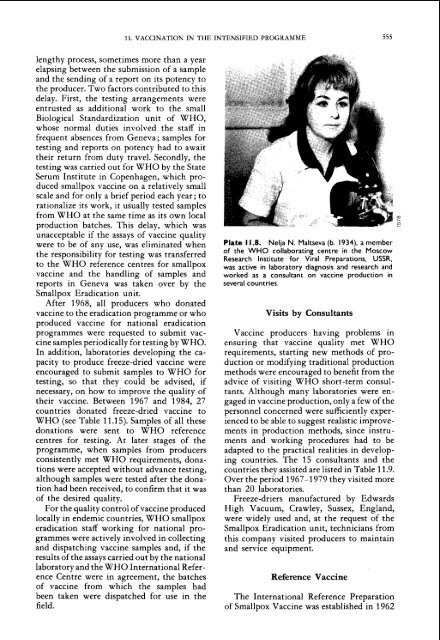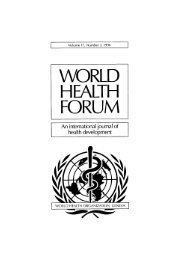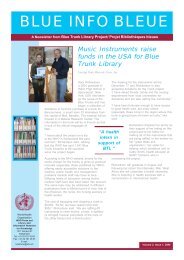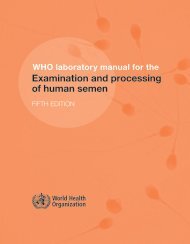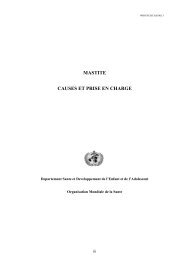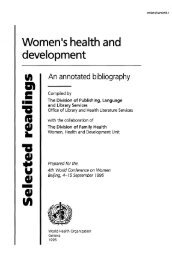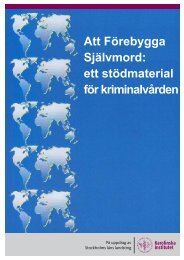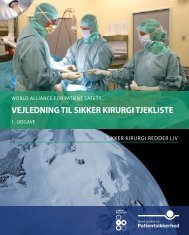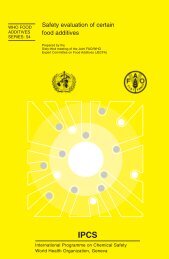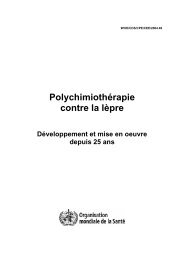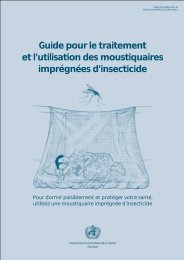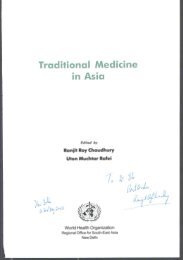smallpox vaccine and vaccination in the intensified ... - libdoc.who.int
smallpox vaccine and vaccination in the intensified ... - libdoc.who.int
smallpox vaccine and vaccination in the intensified ... - libdoc.who.int
You also want an ePaper? Increase the reach of your titles
YUMPU automatically turns print PDFs into web optimized ePapers that Google loves.
lengthy process, sometimes more than a year<br />
elaps<strong>in</strong>g between <strong>the</strong> submission of a sample<br />
<strong>and</strong> <strong>the</strong> send<strong>in</strong>g of a report on its potency to<br />
<strong>the</strong> producer. Two factors contributed to this<br />
delay. First, <strong>the</strong> test<strong>in</strong>g arrangements were<br />
entrusted as additional work to <strong>the</strong> small<br />
Biological St<strong>and</strong>ardization unit of WHO,<br />
<strong>who</strong>se normal duties <strong>in</strong>volved <strong>the</strong> staff <strong>in</strong><br />
frequent absences from Geneva; samples for<br />
test<strong>in</strong>g <strong>and</strong> reports on potency had to await<br />
<strong>the</strong>ir return from duty travel. Secondly, <strong>the</strong><br />
test<strong>in</strong>g was carried out for WHO by <strong>the</strong> State<br />
Serum Institute <strong>in</strong> Copenhagen, which pro-<br />
duced <strong>smallpox</strong> <strong>vacc<strong>in</strong>e</strong> on a relatively small<br />
scale <strong>and</strong> for only a brief period each year; to<br />
rationalize its work, it usually tested samples<br />
from WHO at <strong>the</strong> same time as its own local<br />
production batches. This delay, which was<br />
unacceptable if <strong>the</strong> assays of <strong>vacc<strong>in</strong>e</strong> quality<br />
were to be of any use, was elim<strong>in</strong>ated when<br />
<strong>the</strong> responsibility for test<strong>in</strong>g was transferred<br />
to <strong>the</strong> WHO reference centres for <strong>smallpox</strong><br />
<strong>vacc<strong>in</strong>e</strong> <strong>and</strong> <strong>the</strong> h<strong>and</strong>l<strong>in</strong>g of samples <strong>and</strong><br />
reports <strong>in</strong> Geneva was taken over by <strong>the</strong><br />
Smallpox Eradication unit.<br />
After 1968, all producers <strong>who</strong> donated<br />
<strong>vacc<strong>in</strong>e</strong> to <strong>the</strong> eradication programme or <strong>who</strong><br />
produced <strong>vacc<strong>in</strong>e</strong> for national eradication<br />
programmes were requested to submit vac-<br />
c<strong>in</strong>e samples periodically for test<strong>in</strong>g by WHO.<br />
In addition, laboratories develop<strong>in</strong>g <strong>the</strong> ca-<br />
pacity to produce freeze-dried <strong>vacc<strong>in</strong>e</strong> were<br />
encouraged to submit samples to WHO for<br />
test<strong>in</strong>g, so that <strong>the</strong>y could be advised, if<br />
necessary, on how to improve <strong>the</strong> quality of<br />
<strong>the</strong>ir <strong>vacc<strong>in</strong>e</strong>. Between 1967 <strong>and</strong> 1984, 27<br />
countries donated freeze-dried <strong>vacc<strong>in</strong>e</strong> to<br />
WHO (see Table 11.1 5). Samples of all <strong>the</strong>se<br />
donations were sent to WHO reference<br />
centres for test<strong>in</strong>g. At later stages of <strong>the</strong><br />
programme, when samples from producers<br />
consistently met WHO requirements, dona-<br />
tions were accepted without advance test<strong>in</strong>g,<br />
although samples were tested after <strong>the</strong> dona-<br />
tion had been received, to confirm that it was<br />
of <strong>the</strong> desired quality.<br />
For <strong>the</strong> quality control of <strong>vacc<strong>in</strong>e</strong> produced<br />
locally <strong>in</strong> endemic countries, WHO <strong>smallpox</strong><br />
eradication staff work<strong>in</strong>g for national pro-<br />
grammes were actively <strong>in</strong>volved <strong>in</strong> collect<strong>in</strong>g<br />
<strong>and</strong> dispatch<strong>in</strong>g <strong>vacc<strong>in</strong>e</strong> samples <strong>and</strong>, if <strong>the</strong><br />
results of <strong>the</strong> assays carried out by <strong>the</strong> national<br />
laboratorv <strong>and</strong> <strong>the</strong> WHO International Refer-<br />
ence Centre were <strong>in</strong> agreement, <strong>the</strong> batches<br />
of <strong>vacc<strong>in</strong>e</strong> from which <strong>the</strong> samples had<br />
been taken were dispatched for use <strong>in</strong> <strong>the</strong><br />
field.<br />
11. VACCINATION IN THE INTENSIFIED PROGRAMME 555<br />
Plate 11.8. Nelja N. Maltseva (b. 1934). a member<br />
of <strong>the</strong> WHO collaborat<strong>in</strong>g centre <strong>in</strong> <strong>the</strong> Moscow<br />
Research Institute for Viral Preparations. USSR.<br />
was active <strong>in</strong> laboratory diagnosis <strong>and</strong> research <strong>and</strong><br />
worked as a consultant on <strong>vacc<strong>in</strong>e</strong> production <strong>in</strong><br />
several countries.<br />
Visits by Consultants<br />
Vacc<strong>in</strong>e producers hav<strong>in</strong>g problems <strong>in</strong><br />
ensur<strong>in</strong>g that <strong>vacc<strong>in</strong>e</strong> quality met WHO<br />
requirements, start<strong>in</strong>g new methods of production<br />
or modify<strong>in</strong>g traditional production<br />
methods were encouraged to benefit from <strong>the</strong><br />
advice of visit<strong>in</strong>g " WHO short-terk consultants.<br />
Although many laboratories were engaged<br />
<strong>in</strong> <strong>vacc<strong>in</strong>e</strong> production, only a few of <strong>the</strong><br />
~ersonnel concerned were suflicientlv , exDer- L<br />
ienced to be able to suggest realistic improvements<br />
<strong>in</strong> production methods, s<strong>in</strong>ce <strong>in</strong>struments<br />
<strong>and</strong> work<strong>in</strong>g procedures had to be<br />
adapted to <strong>the</strong> prac~ical realities <strong>in</strong> develop<strong>in</strong>g<br />
countries. The 15 consultants <strong>and</strong> <strong>the</strong><br />
countries <strong>the</strong>y assisted are listed <strong>in</strong> Table 11.9.<br />
Over <strong>the</strong> period 1967-1979 <strong>the</strong>y visited more<br />
than 20 laboratories.<br />
Freeze-driers manufactured by Edwards<br />
High Vacuum, Crawley, Sussex, Engl<strong>and</strong>,<br />
were widely used <strong>and</strong>, at <strong>the</strong> request of <strong>the</strong><br />
Smallpox Eradication unit, technicians from<br />
this company visited producers to ma<strong>in</strong>ta<strong>in</strong><br />
<strong>and</strong> service equipment.<br />
Reference Vacc<strong>in</strong>e<br />
The International Reference Preparation<br />
of Smallpox Vacc<strong>in</strong>e was established <strong>in</strong> 1962


